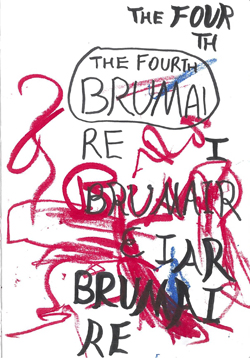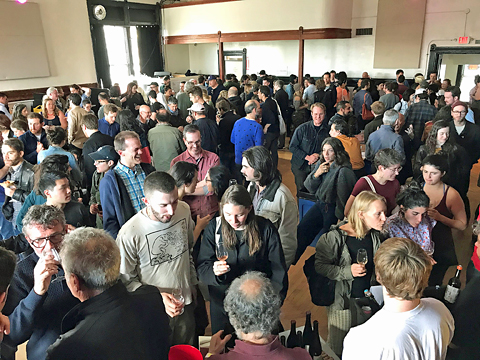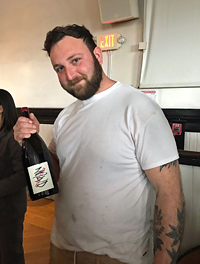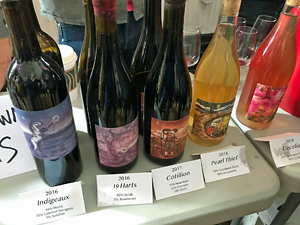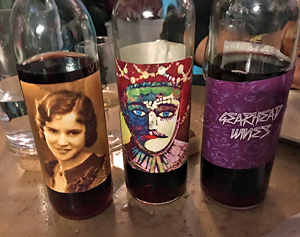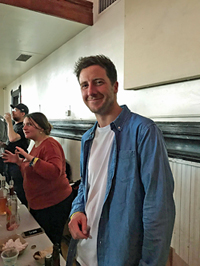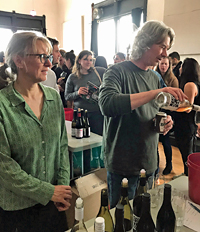Absentee Winery
Owner/winemaker Avi Deixler launched his Absentee label in 2016. He makes his wine in Point Reyes Station in western Marin County, and sources fruit from Poor Ranch in Mendocino County. My favorite of the wines that Avi poured me was the 2017 “NMWD Private Stash” Carignan, from magnum. I liked the basic “NMWD” bottling for its upfront fruit, but the “Private Stash” – with more barrel age – added more earthy and stony mineral elements, while retaining the basic bottling’s dark berry aromas and bright acidity. The 2016 “Western Art” Petite Sirah was also noteworthy, with black fruits, floral notes, and chalky tannins.
AmByth Estate
AmByth is the project of Phillip Hart and Mary Morwood Hart. Their biodynamic Paso Robles-area vineyard features dry-farmed and head-trained vines. Philip makes the wines along with son Gelert, who also manages the vineyard. I thought the standout among the AmByth wines at Brumaire was the 2013 Mourvèdre – loads of spice along with earthy red fruit, with fine acidity and a lively finish.
Caleb Leisure Wines
Caleb worked at wineries in France and California (notably for Coturri Winery, where Caleb also makes his own wines) before starting his own label in 2016. He may be the first vintner in California to make all his wines in traditional Georgian qvevri – large clay amphoras buried in the ground. He currently has ten of them. Caleb and his wife Caroline were behind the winery table and poured four wines, all of which were very good. The 2018 “Ab Ovo” blend of 70% Mourvèdre and 30% Marsanne from El Dorado County was very pleasant, and the 2018 “Verso” Sauvignon Blanc / Sémillon blend from the Yorkville Highlands was even better, with stone fruit aromas, great acidity, and a chalky mineral texture. My favorite was the 2017 “Aporia” Syrah from the Fountaingrove AVA of Sonoma County. Earthy dark berry fruit with floral undertones, bright texture, with a stony mineral finish.
Clos Saron
Based in Yuba County in the northern Sierra Foothills, Clos Saron’s Gideon Beinstock has been a longtime proponent of natural winemaking. He poured a strong group of six wines at Brumaire. The 2015 “A Pleasant Peasant” comes from Carignan planted in 1900 in Lodi, and displayed classic Carignan character – earthy, plummy, spicy, a bit rustic. The 2013 Home Vineyard “Old Block” Pinot Noir had intense black cherry, earth, and savory aromas with a “sauvage” element and fine acidity. My favorite of the Clos Saron wines was the 2014 “Stone Soup” Syrah. This was co-fermented with about 7% Viognier, and featured dark berry fruit along with floral, meaty, and stony mineral aromas, with a lively mouthfeel and firmly tannic finish.
Frenchtown Farms
Proprietors Aaron & Cara Mockrish were on hand to pour their wines at Brumaire. They make their wines at the Clos Saron facility in the Sierra Foothills and farm several vineyard blocks not far away – most of their fruit comes from there. I thought two of their wines were particular highlights. The 2018 “The Pearl Thief” is 70% Sauvignon Blanc and 30% Roussanne, and showed both citrus and tropical fruit notes with vibrant acidity and a tasty finish. The 2016 “19 Harts” is 95% Syrah plus 5% co-fermented Roussanne. Bright and minerally, with savory dark fruits, herbs and a touch of pepper, a lively texture and firm, chalky tannins.
Gearhead
Gearhead is the project of Craig West, who makes his wines in the Bay Area city of Richmond along with several other natural winemakers. His first vintage was 2016, and all of the fruit for his current wines comes from Love Ranch in the lower Sierra Foothills of eastern Madera County. The 2018 “Erotic City Nouveau” is a carbonic co-ferment of Grenache and Syrah, and it showed bright red fruit, flowers, and spice on the nose, with good acidity – a fun wine. The 2017 “Adaline” is 100% whole-cluster fermented Grenache, displaying red fruits, herbs, and earth, a structured mouthfeel and chalky tannins on the finish.
GoGo Wine / Artanuli Gvino
One of a number of Georgian producers at this year’s Brumaire, vintner Ketevan Berishvili comes from a winemaking family. From the Kakheti region, she made her first GoGo wines in 2015. Ketevan was on hand at the event, and I enjoyed her 2017 “Cuvée Bébés,” a blend of Rkatsiteli and Mtsvane, two of the best-known white grape varieties from Georgia. 70% of the fruit was fermented on the skins, and the wine spent seven months in a traditional qvevri. This featured pear, earth, spice aromas with skin-fermented phenolic undertones, great texture and a chalky finish.
Kindeli
Kindeli’s Alex Craighead was on hand to pour his wines at the tasting. I believe he’s the first vintner from New Zealand to pour at Brumaire – he’s based in the northern part of New Zealand’s South Island. His vineyard includes Sauvignon Blanc, Riesling, Pinot Gris, Gewürztraminer, Chardonnay, Pinot Noir, and Syrah. The 2018 “Otoño” is a blend of Riesling and Gewürztraminer, made in amphora and partially fermented on the skins. The floral and spicy lychee aromatics of the Gewürztraminer component were foremost in the blend, which had medium body and lively acidity.
|
La Clarine Farm
From El Dorado County in the Sierra Foothills, La Clarine Farm produces a number of distinctive varietals and blends from fruit grown in their area. Husband-and-wife team of Hank Beckmeyer and Caroline Hoël poured their wines at the tasting, and two of them were particular highlights for me. The 2017 “Mo-Ma” is a blend of Mourvèdre and Marsanne, plus a small amount of Roussanne. Aromas of plum and pear fruit, earth and phenolic notes, plus a savory herbal component, with lighter body and a bright mouthfeel. The 2017 “Cedarville” Mourvèdre featured bright plum and darker fruit, earth, dried herbs, and stony minerals, with a lively texture and moderate tannins.
La Lunotte
La Lunotte is located in the Touraine region of the Loire Valley, where vintner Christophe Foucher launched his winery in the early 2000s. He prefers not to use that AOC on his labels, opting for the broader Vin de France (VDF) designation. The 2016 “Trio,” a blend of Sauvignon Blanc and Menu Pineau from the estate’s biodynamically-farmed vineyard, featured earthy and herbal aromas with citrus fruit and a stony mineral note, medium weight on the palate with a slightly chalky character on the finish.
La Onda
Vintner Dani Rozman of La Onda sources most of his fruit from the northern Sierra Foothills and makes his wines at the Clos Saron facility. My favorites of the wines he poured at Brumaire both came from fruit he farms nearby in Yuba County. The 2017 “Blanco de Tinto” is whole-cluster pressed Cabernet Sauvignon, and had lots of spice aromas along with wild berry and earth notes, with a vibrant texture. The 2017 “Amor Amarillo” – a blend of about 67% Sémillon and 33% Sauvignon Blanc – was earthy and herbal, with a lively mouthfeel and chalky mineral finish.
Marina Kurtanidze
Marina co-founded the first winery in Georgia established by women, in 2012. She poured just one wine at Brumaire, the 2017 Marina Mtsvane, which spent six months on the skins. Light amber in color, this displayed bright floral and stone fruit aromas along with an earthy phenolic element, with medium body and a mineral note on the finish.
Old World Winery
Vintner Darek Trowbridge was on hand to pour his Old World Winery wines. His winery is in Russian River Valley, and he comes from that region’s famed Martinelli family. He sources fruit from some of the old Martinelli vineyards planted well over 100 years ago. The 2015 “Early Harvest” Sparkling Arbouriou was my favorite of Darek’s wines – from a red grape variety that’s now rare in California, this wine spent a year in barrel and three in bottle prior to release. It was lightly sparkling, plummy, earthy, and a bit spicy with a somewhat rustic character and fairly light body.
Oriol Artigas
Catalonia’s Oriol Artigas was behind his winery table again this year, and as has been the case in the past, I found his white wines in particular to be standouts. The 2017 “La Rumbera” is made from Pansa Blanca (also known as Xarel·lo), fermented with 20% skin contact and aged for ten months. This displayed bright and earthy pear and stone fruit aromas with lighter weight and vibrant acidity on the palate and a clean, fresh finish. The 2017 “La Bestia” – also from Pansa Blanca – was more intense. Destemmed and kept on the skins for five days before pressing, this had a similar aromatic profile to the “La Rumbera” but with added complexity of phenolic and saline mineral elements, plus a bigger texture on the palate and finish.
Purity Wines
Vintner Noel Diaz makes his Purity wines in Richmond, California, and gets much of his fruit from the Sierra Foothills. I tasted four Syrahs at the Purity table (one of them a Pét-Nat), and my favorites were both sourced from Oakstone Vineyard in Nevada County, in the northern Sierra Foothills. The 2015 “Blue Licorish” Syrah featured higher-toned blackberry fruit along with spice and herb notes, with a lively mouthfeel. I thought the 2017 “Quench!” Syrah was a step up, with more focused fruit, earth, and slightly floral notes along with an iron mineral quality, and more structured texture and finish.
Rajat Parr Wine Club
Raj Parr was on hand to pour a selection of his wines at Brumaire. These bottlings are distinct from those of the Domaine de la Côte, Sandhi, and Evening Land wines, and are available through Raj’s wine club. I thought two of the wines were standouts. The 2018 “Candyfloss” Pinot Gris from San Benito County was a ramato-style wine, with both pear and red fruit aromas, a lively texture, and pleasant finish. My favorite of the Raj Parr wines was the 2017 Gamay Noir / Pinot Noir from Eola-Amity Hills in the Willamette Valley. This is a 50/50 blend of the two varieties, and had bright cranberry and herb aromas, lighter weight on the palate, and a chalky mineral finish.
Ruth Lewandowski
Evan Lewandowski sources the fruit for his wines from Mendocino County, though his base of operations has been in Salt Lake City. He mentioned at Brumaire that he’s recently moved to California, which should certainly simplify his winemaking life! He poured a strong line-up of wines, and two in particular were highlights for me. The 2018 “Rosé Cuvée Zero” includes Tinto Roriz, Souzão, and Touriga Nacional, and featured intense red fruit, herbs, and a touch of spice, with vibrant acidity and a fresh finish. The 2018 “Feints Cuvée Zero” – from about 40% Arneis plus Barbera, Nebbiolo, and Dolcetto, and made by partial carbonic fermentation – was earthy and herbal, with black cherry and plum fruit and a stony mineral component, with a lively texture and moderate tannins.
Stirm
Ryan Stirm makes his wines in the small town of Aromas, between Santa Cruz and Monterey. Ryan sources fruit from the northern Central Coast as well as from Santa Barbara County. I thought that two of the wines that Ryan poured at the tasting really stood out, both sourced from the same San Benito County vineyard. The 2017 Wirz Vineyard Riesling was kept on the skins for 24 hours before pressing, then made in stainless steel. This had bright citrus and stone fruit aromas plus a touches of petrol and flowers, with medium weight and nice texture. The 2017 Wirz Vineyard Zinfandel was fermented in a 50-year old redwood tank, and in an unusual twist, it was blended with 18.5% Riesling. This displayed ripe Zin fruit and spice, while the Riesling component added floral notes and most likely bumped up the acidity for a lively mouthfeel and finish.
Tamuna Bidzinashvili
Vintner Tamuna Bidzinashvili poured several of her wines at Brumaire. From the Kakheti region of Georgia, she produces wines under the Tamuna’s Wine label from Rkatsiteli, Saperavi, and a number of other local grape varieties. My favorite of the wines that Tamuna poured was the 2016 Kakhuri Mtsvane, which spent six months on the skins. This was floral and phenolic, with spice and stone fruit in support, plenty of texture on the palate, and a chalky mineral finish.
Woods Wines / Divine Origins
Winemaker Amato Salvatierra was behind the table at the tasting, pouring a number of selections from two new projects from Woods Beer Co. He poured three wines, plus three intriguing Divine Origins wine / beer blends – those start out as fermenting wine, then unfermented beer is added to the mix. Of those three, the Albariño Blonde Ale was my favorite though I didn’t take notes on these blends. Of the three Woods wines – all made on Treasure Island in San Francisco Bay – I particularly liked the 2018 “Out of Irons” Pinot Noir from McEvoy Ranch in Petaluma Gap. This had a savory profile with bright red fruit and herb notes, lively acidity, and fine tannins.
Zumo
This was the final producer I checked out at Brumaire. The vintners are Diego Perez (who works at Ordinaire) and his partner Georgia – they make their wine in the same Richmond facility as Purity and several other producers, and the two wines they poured will be their inaugural releases. I especially enjoyed the 2018 “Flower Face” that Georgia poured for me. A blend of 75% Tempranillo from Rorick Vineyard in Calaveras County and 25% Muscat from Contra Costa County, this was a lighter-bodied red displaying black cherry and plum aromas along with floral overtones but not the overpowering perfumey character that Muscat can bring – this was a pleasant and different blend.
|


